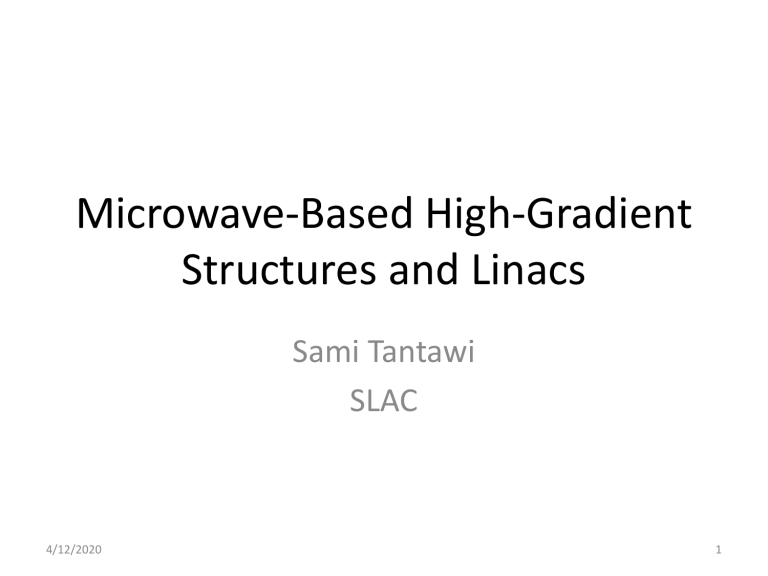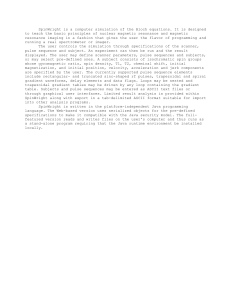Optimized Pi-mode Accelerator structure
advertisement

Microwave-Based High-Gradient Structures and Linacs Sami Tantawi SLAC 4/12/2020 1 Acknowledgment • The work being presented is due to the efforts of – V. Dolgashev, L. Laurent, F. Wang, J. Wang, C. Adolphsen, D. Yeremian, J. Lewandowski, C. Nantista, J. Eichner, C. Yoneda, C. Pearson, A. Hayes, D. Martin, R. Ruth, S. Pei, Z. Li SLAC – T. Higo and Y. Higashi, et. al., KEK – W. Wuensch et. al., CERN – R. Temkin, et. al., MIT – W. Gai, et. al, ANL – J. Norem, ANL – G. Nusinovich et. al., University of Maryland – S. Gold, NRL – Bruno Spataro, INFN Frscati 4/12/2020 2 Overview • Review of experimental data on high gradient structure • Efficiency and standing wave accelerator structure designs • A 1 TeV collider – Improved efficiency – Possible parameter set 4/12/2020 3 Research and Development Plan 4/12/2020 Experimental Studies • Basic Physics Experimental Studies – Single and Multiple Cell Accelerator Structures (with major KEK and CERN contributions) • single cell traveling-wave accelerator structures (Needs ASTA) • single-cell standing-wave accelerator structures (Performed at Klystron Test Lab) – Waveguide structures (Needs ASTA) – Pulsed heating experiments (Performed at the Klystron Test Lab, also with major KEK and CERN contributions) • Full Accelerator Structure Testing (Performed at NLCTA, with CERN contributions) Can only be done at NLCTA at SLAC 4/12/2020 5 BreakdownProbability 1 pulse m Breakdown Probability for a Standing Wave Accelerator Structure with a/l=0.22 Flat Top Pulse width 0.1 0.001 Typical gradient (loaded) as a function of time. 600ns 10 5 150ns Pulsed Temp Rise 10 7 60 80 100 120 140 Accelerating Gradient MV m 4/12/2020 6 Breakdown Probability for a Standing Wave Accelerator Structure with a/l=0.14 BreakdownProbability 1 pulse m 0.01 Flat Top Pulse width 0.001 300ns 10 4 10 5 200ns 10 6 150ns 10 7 100 110 120 130 140 150 160 170 Accelerating Gradient MV m 4/12/2020 7 Breakdown Probability for a Standing Wave Accelerator Structure with a/l=0.1 BreakdownProbability1 pulsem 0.1 Flat Top Pulse width 0.01 600ns 0.001 10 4 400ns 10 5 200ns 10 6 100 120 140 160 180 200 Accelerating Gradient MV m 4/12/2020 8 BreakdownProbability 1 pulse m Breakdown Probability for a Standing Wave Accelerator Structure with different a/l=0.21 0.1 0.01 0.001 10 4 10 5 80 100 120 140 160 180 200 Accelerating Gradient MV m 4/12/2020 9 BreakdownProbability 1 pulse m Breakdown Probability for a Standing Wave Accelerator Structure with different a/l 1 0.1 0.01 0.001 40 50 60 70 80 90 Peak Temprature Rise C 4/12/2020 10 4/12/2020 Page 11 4/12/2020 Page 12 BreakdownProbability 1 pulse m Breakdown Probability for a Standing Wave Accelerator Structure with a/l=0.22 Flat Top Pulse width 1 0.1 600ns 0.01 400ns 0.001 10 4 200ns 10 5 90 100 110 120 130 140 150 Gradient MV m 4/12/2020 13 BreakdownProbability 1 pulse m Breakdown Probability for a Standing Wave Accelerator Structure with a/l=0.22, Pulse length=200ns 0.1 0.01 CuCr Cu 0.001 10 4 CuZr Hard Cu 10 5 90 100 110 120 130 140 150 Gradient MV m We have not tested yet structure with small apertures and different material “Stay Tuned” This is coming very soon 4/12/2020 14 Field Profile over the Iris Es/Ea 2.0 Distance Those two peaks are correlated for structures with different t and a/l 1.5 (Zo Es Hs)1/2/Es 1.0 Hs/Es 0.5 0.0 0.0 4/12/2020 0.2 0.4 0.6 Distance cm 0.8 1.0 1.2 15 Peak H and Peak ExH Peak ZoHsEs Ea 1.6 1.5 1.4 1.3 1.2 1.1 4/12/2020 1.2 1.3 1.4 Peak Hs Ea 1.5 1.6 16 Full Accelerator structure testing ( the T18 Research andstructure) Development Plan Frequency. 11.424GHz Cells 18+input+output Filling Time 36ns a_in/a_out 4.06/2.66 mm vg_in/vg_out 2.61/1.02 (%c) S11 0.035 S21 0.8 Phase 120Deg Average Unloaded Gradient over the full structure 55.5MW100MV/m Field Amplitude Eacc _ out Eacc _ in ~ 1.5 •Structure designed by CERN based on all empirical laws developed experimentally through our previous work •Cells Built at KEK •Structure was bonded and processed at SLAC Cumulated •Structure was also tested at SLAC Phase Change 4/12/2020 120° Page 17 RF Processing of the T18 Structure RF BKD Rate Gradient Dependence for 230ns Pulse at Different Conditioning Time RF BKD Rate Pulse Width Dependence at Different Conditioning Time -4 10 -4 10 After 500hrs RF Condition -5 10 After 900hrs RF Condition -6 10 After 1200hrs RF Condition -7 10 95 100 105 110 Unloaded Gradient: MV/m 115 G=108MV/m BKD Rate: 1/pulse/m BKD Rate: 1/pulse/m After 250hrs RF Condition 10 10 -5 G=108MV/m -6 G=110MV/m 10 -7 100 150 200 RF Flat Top Pulse Width: ns This performance may be good enough for 100MV/m structure for a warm collider, however, it does not yet contain all necessary features such as wakefield damping. Future traveling wave structure designs will also have better efficiency 4/12/2020 Page 18 2007-09 CERN/CLIC Design Structures Tested at NLCTA (Yellow = Quad Cell Geometry, Green = Disk Cell Geometry) In Beamline Structure Note Performance 11/06 – 2/07 C11vg5Q16 First X-band Quad - Irises Slotted Poor: 57 MV/m, 150 ns, 2e-5 BDR – grew whiskers on cell walls 2/08 - 4/08 C11vg5Q16 Redux Refurbished Initially good (105 MV/m, 50 ns,1e-5 BDR) but one cell degraded 4/07 – 10/07 C11vg5Q16-Mo Molybdenum Version of Above Poor: 60 MV/m, 70 ns, 1e-6 BDR 10/08 – 12/08 TD18vg2.6_Quad No Iris Slots but WG Damping Very Poor: would not process above 50 MV/m, 90ns – gas spike after BD 4/08 – 7/08 T18vg2.6-Disk Cells by KEK, Assembled at SLAC Good: 105 MV/m, 230 ns at LC BDR spec of 5e7/pulse/m but hot cell developed 7/08 – 10/08 T18vg2.6-Disk Powered from Downstream End Good: 163 MV/m, 80 ns, 2e-5 BDR in last cell, consistent with forward operation 12/08 – 2/09 T18vg2.6-Disk CERN CERN Built, Operate in Vac Can Very Poor: very gassy with soft breakdowns at 60 MV/m, 70 ns 4/12/2020 Page 19 SQRT(EmaxHmaxZ0)/Ea Emax/Ea HmaxZ0/Ea 4/12/2020 20 T18 Surface Field Parameters in Comparison with SW Structures Emax/Ea SW SW a/l=0.22 SW a/l=0.14 SW a/l=0.1 SQRT(EmaxHmaxZ0)/Ea 4/12/2020 HmaxZ0/Ea 21 So, What does all this imply for a 1 TeV collider parameters? • High gradient requires high power density/unit length, quadratic with gradient. Hence the two beam choice for the CLIC design • However, since one also accelerates in shorter length the total required RF power increases linearly with gradient. ~ x RI ;x s 0 Ea 1 x • High gradient also implies reduced efficiency; • However, one can compensate by increasing the efficiency the accelerator structure and RF sources. – Increasing the efficiency of the accelerator structure would reduce the power/unit length, and it might allow for the use of a conventional RF unit – At the moment the best ( published ) design that respects high gradient constraints imply an RF to beam efficiency of about 28% – Higher efficiency RF source and accelerator efficiency imply lower RF system cost 4/12/2020 22 Yet another Finite Element Code Motivated by the desire •to design codes to perform Large Signal Analysis for microwave tubes (realistic analysis with short computational time for optimization) •study surface fields for accelerators •the need of a simple interface so that one could “play” •A finite element code written completely in Mathematica was realized. •To my surprise, it is running much faster than SuperFish or Superlance •The code was used with a Genetic Global Optimization routine to optimize the cavity shape under surface field constraints Surface field penalty function 1.0 0.6 0.5 0.8 0.4 0.6 0.3 0.2 0.4 4/12/2020 0.1 23 0.2 0.4 0.6 0.8 1.0 1 2 3 4 Iris shaping for a structure with a/l=0.14 Shunt Impedance Quality Factor Peak Es/Ea Peak Z0Hs/Ea 4/12/2020 83 MW/m 8561 2.33 1.23 Shunt Impedance 104 MW/m Quality Factor 9778 Peak Es/Ea 2.41 Peak Z0Hs/Ea 1.12 • With 1 nC/bunch and bunch separation of 6 rf cycles the RF to beam efficiency~70% 24 • The power required/m~287 MW Iris shaping for a structure with a/l=0.1 Shunt Impedance Quality Factor Peak Es/Ea Peak Z0Hs/Ea 4/12/2020 102 MW/m 8645 2.3 1.09 Shunt Impedance 128 MW/m Quality Factor 9655 Peak Es/Ea 2.5 Peak Z0Hs/Ea 1.04 • With 0.5 nC/bunch, bunch separation of 6 rf cycles, and loaded gradient of 100 MV/m the RF to beam efficiency~53% 25 • The power required/m~173 MW Feeding and Wakefield damping of a set of p-mode structures •Each cell is fed through a directional coupler. •The feeding port serve as the damping port •The system has a four-fold symmetry, only one section is shown 4/12/2020 26 Parameter Options for a 1 TeV machine, 2 1034 cm-2 s-1 Option-1 Option-2 Frequency (GHz) Option-3 11.424 Gradient (MV/m) 100 100 80 Power/meter (MW) 287 173 126 1 0.5 0.5 Charge/bunch (nC) Bunch separation ( RF cycles) 6 Number of bunches 300 600 600 <a/l> 0.14 0.1 0.1 Two beam Two Beam/Conventional Unit Conventional Unit RF/Beam Efficiency(%) 73 53 60 Beam duration Pulse length (ns) 158 315 315 Repetition Rate (Hz) 60 60 60 RF source 4/12/2020 27 Conclusion • With recent advances on high gradient accelerator structures, it is possible to think of an “efficient” room temperature collider • Reduced power levels/unit length may permit designs based on conventional RF unit. 4/12/2020 28






